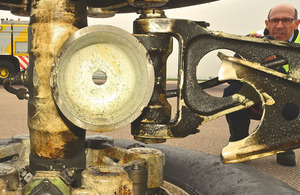Vacancies: Inspectors of Air Accidents (Engineering) - 09 May 2017
The Air Accidents Investigation Branch is recruiting Inspectors of Air Accidents.

Engineering inspector at work
Can you be instrumental in determining causes of civil aircraft accidents and serious incidents worldwide? If so, this Inspector of Air Accidents (Engineering) role is for you, and we’d like to hear from you.
The purpose of this role is to investigate the engineering aspects of aircraft accidents and serious incidents involving civil aircraft operating in the UK and to UK registered or manufactured aircraft overseas.
A full job description and role profile is on the Civil Service Jobs website.
Read about a week in the life of an Engineering Inspector below.
The deadline for applications is 7 June 2017.
A week in the life of Bob Vickery, AAIB Engineering Inspector
I am often asked about what I do. When I tell people, the response I usually get is, “wow, that must be fascinating”.
Well, actually it is. I am an aircraft engineer and after a successful, broad and varied career in the Royal Navy I joined the Air Accidents Investigation Branch (AAIB) four years ago. It was clear to me when I joined and still is today; if you love aircraft, engineering and are inquisitive by nature, enjoy learning and like puzzling things out, this job is ideal.
So what does it really involve?
Weeks are never the same and my time is taken up with the various stages of my investigations into air accidents and incidents large and small. At any one time I can have three or four on the go.
Accidents by their nature are unexpected and can and do happen any time, day or night. My involvement starts after the Branch has been informed that something has happened and I am assigned along with Flight Data and Operations colleagues to the case. This can be an investigation anywhere in the UK or to assist worldwide. I am usually at a high state of readiness to deploy as I move up the AAIB engineering duty rota which ensures at least one of 12 engineers is available 24/7, 365 days per year. Once assigned I deploy to wherever the aircraft might be. It can be anything from a micro-light, to a helicopter or even several hundred tonnes of airliner. The aircraft may be in small pieces in a field or parked at an airport stand with no sign outwardly of anything wrong.
This initial stage is fascinating and may take several days. In many cases I have to temper my enthusiasm given that this may well be a stressful or even life-changing experience for those involved. I need to remain calm and sympathetic to people who may be highly emotional, shocked and upset as I unravel what might be the worst day of their lives. Talking to relatives can be a challenging part of the role, but in some ways it can be rewarding, knowing that I am providing the answers they need to help them understand what happened, which may provide some comfort. I also have to be comfortable in myself, mindful that not all - but some - accident sites are dreadful to say the least. While psychological support is provided, the job is not for the faint-hearted.
Having gathered initial evidence with my colleagues, we formally present to the Chief Inspector and our peers our findings and thoughts as to where we think the investigation is leading.
As the engineering aspect of the investigation progresses, lines of inquiry emerge which require exploring in detail. This often means looking at drawings and manuals to understand the workings and design intent of the systems involved. This may then lead to reconstruction or, conversely, dismantling. I may then need to examine further and test components in our hangar or, if needed, with the manufacturer wherever they may be in the world; the job does involve a lot of travel. One day it might be a simple bolt or fastener, the next, a modern avionic system. I deal with both with an open but methodical and questioning mind with the same attention to detail. I constantly interact with knowledgeable experts at all levels and tact and diplomacy comes to the fore during my work and gets things done.
Rigorous and occasionally lively discussions are held with colleagues as the investigation progresses to identify the facts and causes and to formulate effective safety recommendations to prevent reoccurrence. Throughout the investigation I work towards producing a clear and accurate written report which conveys the circumstances and details of the engineering features of the accident so that it can be read and understood by people within aviation and by ordinary members of the public. I also have to be confident in my investigation when I give evidence publically to the Coroner (or Procurator Fiscal in Scotland).
In between investigations, and sometimes simultaneously for that matter, I have the opportunity to learn and train to improve my aviation knowledge and investigative skills. This might be a short course run by an aircraft manufacturer on their product or a university course looking at, for example, new materials. It can also be an in-house course to hone or refine a specific skill, for example microscope photography. Time is also made available for me to be part of aviation by simulator flying or flying in light aircraft to maintain a private pilot’s licence.
An AAIB engineering inspector is a fascinating and rewarding job. No two weeks are ever the same except for one thing, the knowledge that I and my colleagues are working to make commercial and private aviation safer by understanding what went wrong and what went right during accidents and incidents. Although the job can be difficult in some respects, given the sometimes distressing part my work, it is very rewarding and I thoroughly enjoy coming to work at the AAIB.